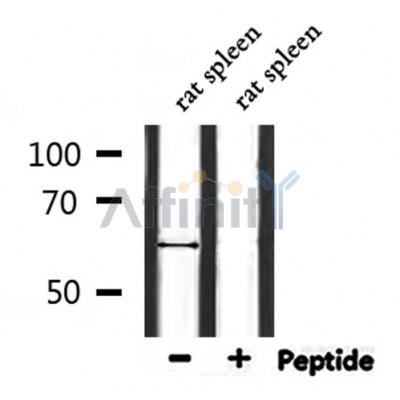ATL1 Antibody - #DF7262
| Product: | ATL1 Antibody |
| Catalog: | DF7262 |
| Description: | Rabbit polyclonal antibody to ATL1 |
| Application: | WB IHC |
| Reactivity: | Human, Mouse, Rat |
| Prediction: | Pig, Bovine, Horse, Sheep, Rabbit, Dog, Chicken, Xenopus |
| Mol.Wt.: | 63kDa; 64kD(Calculated). |
| Uniprot: | Q8WXF7 |
| RRID: | AB_2839201 |
Related Downloads
Protocols
Product Info
*The optimal dilutions should be determined by the end user.
*Tips:
WB: For western blot detection of denatured protein samples. IHC: For immunohistochemical detection of paraffin sections (IHC-p) or frozen sections (IHC-f) of tissue samples. IF/ICC: For immunofluorescence detection of cell samples. ELISA(peptide): For ELISA detection of antigenic peptide.
Cite Format: Affinity Biosciences Cat# DF7262, RRID:AB_2839201.
Fold/Unfold
AD FSP; atl1; ATLA1_HUMAN; Atlastin GTPase 1; Atlastin-1; Atlastin1; Brain specific GTP binding protein; Brain-specific GTP-binding protein; FSP1; GBP-3; GBP3; GTP-binding protein 3; Guanine nucleotide-binding protein 3; Guanylate binding protein 3; hGBP3; HSN1D; Spastic paraplegia 3 protein A; SPG 3A; SPG3; SPG3A; SPG3A gene;
Immunogens
Expressed predominantly in the adult and fetal central nervous system. Measurable expression in all tissues examined, although expression in adult brain is at least 50-fold higher than in other tissues. Detected predominantly in pyramidal neurons in the cerebral cortex and the hippocampus of the brain. Expressed in upper and lower motor neurons (at protein level).
- Q8WXF7 ATLA1_HUMAN:
- Protein BLAST With
- NCBI/
- ExPASy/
- Uniprot
MAKNRRDRNSWGGFSEKTYEWSSEEEEPVKKAGPVQVLIVKDDHSFELDETALNRILLSEAVRDKEVVAVSVAGAFRKGKSFLMDFMLRYMYNQESVDWVGDYNEPLTGFSWRGGSERETTGIQIWSEIFLINKPDGKKVAVLLMDTQGTFDSQSTLRDSATVFALSTMISSIQVYNLSQNVQEDDLQHLQLFTEYGRLAMEETFLKPFQSLIFLVRDWSFPYEFSYGADGGAKFLEKRLKVSGNQHEELQNVRKHIHSCFTNISCFLLPHPGLKVATNPNFDGKLKEIDDEFIKNLKILIPWLLSPESLDIKEINGNKITCRGLVEYFKAYIKIYQGEELPHPKSMLQATAEANNLAAVATAKDTYNKKMEEICGGDKPFLAPNDLQTKHLQLKEESVKLFRGVKKMGGEEFSRRYLQQLESEIDELYIQYIKHNDSKNIFHAARTPATLFVVIFITYVIAGVTGFIGLDIIASLCNMIMGLTLITLCTWAYIRYSGEYRELGAVIDQVAAALWDQGSTNEALYKLYSAAATHRHLYHQAFPTPKSESTEQSEKKKM
Predictions
Score>80(red) has high confidence and is suggested to be used for WB detection. *The prediction model is mainly based on the alignment of immunogen sequences, the results are for reference only, not as the basis of quality assurance.
High(score>80) Medium(80>score>50) Low(score<50) No confidence
PTMs - Q8WXF7 As Substrate
| Site | PTM Type | Enzyme | Source |
|---|---|---|---|
| S10 | Phosphorylation | Uniprot | |
| S15 | Phosphorylation | Uniprot | |
| S22 | Phosphorylation | Uniprot | |
| S23 | Phosphorylation | Uniprot | |
| S45 | Phosphorylation | Uniprot | |
| S71 | Phosphorylation | Uniprot | |
| K287 | Ubiquitination | Uniprot | |
| K334 | Ubiquitination | Uniprot | |
| K400 | Ubiquitination | Uniprot | |
| S414 | Phosphorylation | Uniprot | |
| Y429 | Phosphorylation | Uniprot | |
| Y432 | Phosphorylation | Uniprot |
Research Backgrounds
GTPase tethering membranes through formation of trans-homooligomers and mediating homotypic fusion of endoplasmic reticulum membranes. Functions in endoplasmic reticulum tubular network biogenesis. May also regulate Golgi biogenesis. May regulate axonal development.
Endoplasmic reticulum membrane>Multi-pass membrane protein. Golgi apparatus membrane>Multi-pass membrane protein. Cell projection>Axon.
Note: Localizes to endoplasmic reticulum tubular network (PubMed:27619977).
Expressed predominantly in the adult and fetal central nervous system. Measurable expression in all tissues examined, although expression in adult brain is at least 50-fold higher than in other tissues. Detected predominantly in pyramidal neurons in the cerebral cortex and the hippocampus of the brain. Expressed in upper and lower motor neurons (at protein level).
Monomer as apoprotein and in the GDP-bound form. Homodimer in the GTP-bound form. Interacts (via N-terminal region) with MAP4K4 (via CNH regulatory domain). Interacts with REEP5, RTN3 and RTN4 (via the transmembrane region). Interacts with SPAST; interaction is direct. May interact with TMED2. Interacts with REEP1. Interacts with CPT1C. Interacts with ARL6IP1 (By similarity). Interacts with ZFYVE27.
Belongs to the TRAFAC class dynamin-like GTPase superfamily. GB1/RHD3-type GTPase family. GB1 subfamily.
References
Restrictive clause
Affinity Biosciences tests all products strictly. Citations are provided as a resource for additional applications that have not been validated by Affinity Biosciences. Please choose the appropriate format for each application and consult Materials and Methods sections for additional details about the use of any product in these publications.
For Research Use Only.
Not for use in diagnostic or therapeutic procedures. Not for resale. Not for distribution without written consent. Affinity Biosciences will not be held responsible for patent infringement or other violations that may occur with the use of our products. Affinity Biosciences, Affinity Biosciences Logo and all other trademarks are the property of Affinity Biosciences LTD.
